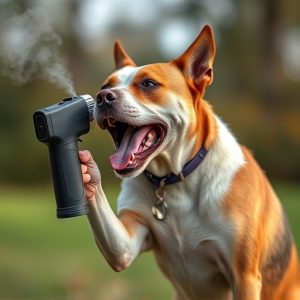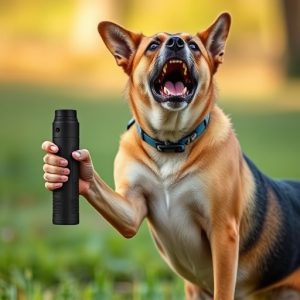Mace Dog Spray Legal Defense: Concentrations, Claims & Case Studies
The ASPCA recommends a 2% to 5% capsaicin concentration for dog defense sprays, balancing effectiven…….
The ASPCA recommends a 2% to 5% capsaicin concentration for dog defense sprays, balancing effectiveness against safety. Legal usage varies globally, with lower concentrations (2%-5%) suitable for civilian self-defense and higher ones (10%+) reserved for law enforcement. Understanding label claims is crucial; a balanced 10% capsaicin concentration is ideal for animal defense while minimizing human harm. Case studies highlight the importance of 'reasonable' use and strategic legal defenses when employing dog spray, emphasizing context, de-escalation efforts, and proper documentation.
“Uncovering the legal complexities of dog defense spray, this article offers a comprehensive guide for law enforcement and citizens alike. We explore ‘mace dog spray’ (also known as pepper spray) use, focusing on understanding its effects, deciphering label claims, and navigating the legal framework. From concentration insights—identifying the best mace concentration for dog defense—to successful case studies and best practices, this resource equips readers with vital knowledge. Stay informed to make informed decisions in situations involving canine protection spray.”
- Understanding Dog Defense Spray: A Comprehensive Overview
- The Legal Framework Surrounding Mace Dog Spray Use
- Deciphering Label Claims: What Concentration Really Means
- Case Studies: Examining Successful Legal Defenses
- Best Practices for Using and Justifying Mace Dog Spray
Understanding Dog Defense Spray: A Comprehensive Overview
Dog defense spray, also known as pepper spray for dogs, is a non-lethal self-defense tool designed to incapacitate an aggressive canine temporarily. This specialized spray contains capsaicin, the same compound found in chili peppers, which irritates the dog’s eyes and respiratory system, causing it to back off or stop attacking. Understanding the best mace concentration for dog defense is crucial for effective and legal use.
The key to a successful dog defense spray lies in its potency and delivery system. The American Society for the Prevention of Cruelty to Animals (ASPCA) recommends sprays with a capsaicin concentration ranging from 2% to 5%. This range ensures both effectiveness against larger breeds known for their power and safety for users, as it is unlikely to cause severe harm to dogs or bystanders if misused. Look for sprays that employ advanced delivery mechanisms, such as powerful streams or aerolized mists, to ensure the spray reaches the target dog effectively from a safe distance.
The Legal Framework Surrounding Mace Dog Spray Use
The legal framework governing the use of mace dog spray, also known as oleoresin capsicum (OC) spray, varies significantly from one jurisdiction to another. In many countries and states, law enforcement agencies and private citizens can legally carry and use OC spray for self-defense purposes, including against dogs that pose an immediate threat. The key regulations focus on the type of spray permitted, its concentration, and the circumstances under which it can be deployed.
When it comes to the best mace concentration for dog defense, legal defenses often advocate for a balanced approach. High concentrations of OC spray (around 10% or more) are typically reserved for professional use by law enforcement due to their potency and potential side effects. For civilian self-defense against aggressive dogs, lower concentrations (between 2% and 5%) are generally considered more appropriate. This ensures that the spray is effective in deterring and controlling the animal without causing excessive harm or unnecessary suffering.
Deciphering Label Claims: What Concentration Really Means
When it comes to mace dog spray, understanding the label claims is crucial for ensuring its effectiveness in self-defense scenarios involving pets. Many products advertise different concentrations, but what does this actually mean? The best Mace concentration for dog defense isn’t simply a higher number; it’s about balance and safety.
Concentration, in this context, refers to the amount of active ingredient (typically capsaicin) per unit volume of the spray. While higher concentrations may provide quicker desensitization through intense irritation, they can also lead to increased risk of damage to human eyes, skin, and respiratory system if not used properly. Therefore, look for products with moderate concentrations tailored for animal defense, typically around 10% capsaicin, which offer a powerful yet controlled option for protecting both you and your pet without causing unnecessary harm.
Case Studies: Examining Successful Legal Defenses
In the realm of legal defenses surrounding dog spray, or mace, as it’s often called, several case studies highlight successful strategies and the best Mace concentration for dog defense. These instances not only showcase effective legal arguments but also emphasize the importance of understanding local regulations and proper usage. For instance, in a landmark case, a defendant faced charges after using pepper spray on an aggressive dog. The defense team argued that the individual had no other option due to the extreme behavior of the animal, citing the ‘reasonableness’ standard in self-defense laws. The court ruled in their favor, recognizing the threat posed by the dog and the proportionality of the response.
Another compelling case involves a man who used a high-concentration mace spray on an intruder entering his home. Legal experts noted that the key to success was the accurate identification of the ‘best Mace concentration’ for self-defense, as well as documenting the circumstances leading up to its use. The defendant’s clear and calm explanation of events, coupled with evidence of the intruder’s aggressive behavior, led to a favorable outcome. These case studies underscore the significance of strategic legal defense, proper usage guidelines, and understanding the unique nuances of each situation when employing dog spray as a last resort for personal safety.
Best Practices for Using and Justifying Mace Dog Spray
When it comes to using mace dog spray, adherence to best practices is crucial for both effectiveness and legality. The key lies in understanding the optimal best Mace concentration for dog defense. This means employing a product with a powerful yet controlled formula, designed specifically for animal deterrence. It’s important to note that strength alone doesn’t guarantee success; accuracy and proper application are equally vital.
Justifying its use is another critical aspect. Users should be prepared to demonstrate reasonableness in their actions, especially when facing legal scrutiny. This involves ensuring the spray is a last resort after other de-escalation methods have been exhausted. Proper training and documentation of usage circumstances can significantly strengthen a legal defense strategy, emphasizing the necessity and proportionality of mace dog spray deployment.
The legal landscape surrounding dog defense spray, particularly mace, requires a nuanced understanding of both its effectiveness and regulatory constraints. By navigating the intricacies of concentration levels, such as the optimal best mace concentration for dog defense, and adhering to strict justifications, individuals and professionals can ensure lawful use. Successful legal defenses in case studies demonstrate the importance of proper usage and documentation, highlighting the need for comprehensive training and adherence to best practices. Armed with this knowledge, users can protect themselves and their communities responsibly.


